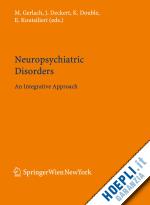The meeting of minds and times with Peter Riederer: an appreciation.- Succi nervorum: a brief history of neurochemistry.- Neuronal differentiation and long-term culture of the human neuroblastoma line SH-SY5Y.- Endogenous oxidized indoles share inhibitory potency against [3H]isatin binding in rat brain.- Lipid content determines aggregation of neuromelanin granules in vitro.- Hydrogen peroxide is a true first messenger.- The therapeutic potential of siRNA in gene therapy of neurodegenerative disorders.- Tyrosinase is not detected in human catecholaminergic neurons by immunohistochemistry and Western blot analysis.- Luteolin protects rat PC 12 and C6 cells against MPP+ induced toxicity via an ERK dependent Keapl-Nrf2-ARE pathway.- Behavioural and expressional phenotyping of nitric oxide synthase-I knockdown animals.- Animal models in neurodegenerative diseases.- Morphological substrates of parkinsonism with and without dementia: a retrospective clinico-pathological study.- Ginsenoside Rd attenuates neuroinflammation of dopaminergic cells in culture.- Biochemistry of postmortem brains in Parkinson’s disease: historical overview and future prospects.- Neuroprotection by propargylamines in Parkinson’s disease: intracellular mechanism underlying the anti-apoptotic function and search for clinical markers.- Intrastriatal transplantation of mouse bone marrow-derived stem cells improves motor behavior in a mouse model of Parkinson’s disease.- Low dose methylphenidate improves freezing in advanced Parkinson’s disease during off-state.- The long-term effects of the neurotoxin l-trichloromethyl-1,2,3,4-tetrahydro-?-carboline (TaClo) on cognitive performance in rats.- Observations on the cortical silent period in Parkinson’s disease.- CYP 2E1 mutant mice are resistant to DDC-induced enhancement of MPTP toxicity.- Pharmacokinetic studies of (—)-deprenyl and some of its metabolites in mouse.- Serum lipoprotein profile and APOE genotype in Alzheimer’s disease.- VITA study: white matter hyperintensities of vascular and degenerative origin in the elderly.- ?-Lipoic acid as a new treatment option for Alzheimer’s disease — a 48 months follow-up analysis.- Long-term abnormalities in brain glucose/energy metabolism after inhibition of the neuronal insulin receptor: implication of tau-protein.- Long-term tetrahydroaminoacridine treatment and quantitative EEG in Alzheimer’s disease.- Enhanced apoptosis, oxidative stress and mitochondrial dysfunction in lymphocytes as potential biomarkers for Alzheimer’s disease.- Central insulin resistance as a trigger for sporadic Alzheimer-like pathology: an experimental approach.- Brain antioxidant capacity in rat models of betacytotoxic-induced experimental sporadic Alzheimer’s disease and diabetes mellitus.- Improving linear modeling of cognitive decline in patients with mild cognitive impairment: comparison of two methods.- Interaction of attention and graphomotor functions in children with attention deficit hyperactivity disorder.- Therapeutic drug monitoring of antidepressants — clinical aspects.- The immunological basis of glutamatergic disturbance in schizophrenia: towards an integrated view.- Deficits of neuronal glutamatergic markers in the caudate nucleus in schizophrenia.- Therapeutic drug monitoring of tricyclic antidepressants in everyday clinical practice.- FZD3 is not a risk gene for schizophrenia: a case-control study in a Caucasian sample.- Impaired cortical inhibition in adult ADHD patients: a study with transcranial magnetic stimulation*.- Association of Parkinson’s disease with symptoms of attention deficit hyperactivity disorder in childhood.- Biostatistical analysis of gene microarrays reveals diverse expression clusters between macaque subspecies in brain SIV infection.- Kynurenines, redox disturbances and neurodegeneration in multiple sclerosis.- Neural stem cell transplantation in a model of fetal alcohol effects.












